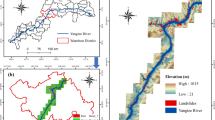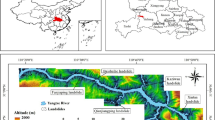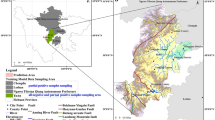Abstract
Landslide displacement prediction is a challenging and important subject in landslide research. To improve the prediction accuracy of and reduce disasters caused by landslides, we propose a selective ensemble deep bidirectional Random Vector Functional Link Network (sedb-RVFLN) for landslide displacement prediction in which each independent hidden layer is linked to a different output layer. In this paper, to reduce the number of hidden nodes without affecting the efficiency of network training, an incremental learning method is utilized to make some hidden nodes not randomly chosen. Moreover, we apply selected partial hidden layers instead of all hidden layers to construct a selective ensemble. The ensemble method adopted by sedb-RVFLN does not require training multiple independent networks, and the entire sedb-RVFLN only needs to be trained once. Finally, we conduct extensive experiments on real landslide datasets from the Huangdeng Hydropower Station in China to demonstrate the effectiveness of our model.













Similar content being viewed by others
References
Abmab C, Asab D, Lmbab D, Ccb E, Mc B, Manuel D, Marcelo S, Juan PA (2021) DInSAR and statistical modeling to assess landslides: the case study of Sierras Chicas (central Argentina). J South Am Earth Sci 108:1–11
Aggarwal A, Alshehri M, Kumar M, Alfarraj O, Pardasani KR (2020) Landslide data analysis using various time-series forecasting models. Comput Electr Eng 88:1–11
Cheng Q, Tian Y, Lu X, Huang Y, Ye L (2021) Near-real-time prompt assessment for regional earthquake-induced landslides using recorded ground motions. Comput Geosci 149:1–11
Du H, Song D, Chen Z, Shu H, Guo Z (2020) Prediction model oriented for landslide displacement with step-like curve by applying ensemble empirical mode decomposition and the PSO-ELM method. J Clean Prod 270:1–17
Duman TY (2009) The largest landslide dam in Turkey: tortum landslide. Eng Geol 104:66–79
Gan L, Zhao X, Wu H, Zhong Z (2021) Estimation of remaining fatigue life under two-step loading based on kernel-extreme learning machine. Int J Fatig 148:1–14
Gorum T, Fan X, Westen CJ, Huang RQ, Xu Q, Tang C, Wang G (2011) Distribution pattern of earthquake-induced landslides triggered by the 12 May 2008 Wenchuan earthquake. Geomorphology 133:152–167
Hancox GT, Perrin ND (2009) Green Lake Landslide and other giant and very large postglacial landslides in Fiordland. New Zealand, Quat Sci Rev 28:1020–1036
Huang F, Cao Z, Guo J, Jiang S, Li S, Guo Z (2020) Comparisons of heuristic, general statistical and machine learning models for landslide susceptibility prediction and mapping. Catena 191:1–14
Igwe KC, Oyedum OD, Aibinu AM, Ajewole MO, Moses AS (2021) Application of artificial neural network modeling techniques to signal strength computation. Heliyon 7:1–9
Jibson RW (2007) Regression models for estimating coseismic landslide displacement. Eng Geol 91:209–218
Katuwal R, Suganthan PN (2019) Stacked autoencoder based deep random vector functional link neural network for classification. Appl Soft Comput J 85:1–9
Korup O, Densmore AL, Schlunegger F (2010) The role of landslides in mountain range evolution. Geomorphology 120:77–90
Kushwah GS, Ranga V (2021) Optimized extreme learning machine for detecting ddos attacks in cloud computing. Comput Secur 105:1–21
Le BT, Ha TTL (2019) Hyperspectral image classification based on average spectral-spatial features and improved hierarchical-ELM. Infrared Phys Technol 102:1–8
Li X, Kong J, Wang Z (2012) Landslide displacement prediction based on combining method with optimal weight. Nat Hazards 61(2):635–646
Lian C, Zeng Z, Yao W, Tang H (2014) Extreme learning machine for the displacement prediction of landslide under rainfall and reservoir level. Stoc Environ Res Risk Assess 28(8):1957–1972
Lian C, Zhu L, Zeng Z, Su Y, Yao W, Tang H (2020) Landslide displacement interval prediction using lower upper bound estimation method with pre-trained random vector functional link network initialization. Neural Netw 130:286–296
Liu Q, Jian W, Nie W (2021) Rainstorm-induced landslides early warning system in mountainous cities based on groundwater level change fast prediction. Sustain Cities Soc 69:1–10
Miao S, Hao X, Guo X, Wang Z, Liang M (2017) Displacement and landslide forecast based on an improved version of Saito’s method together with the Verhulst-Grey model. Arab J Geosci 10(3):53
Nayak DR, Dash R, Majhi B, Pachori RB, Zhang Y (2020) A deep stacked random vector functional link network autoencoder for diagnosis of brain abnormalities and breast cancer. Biomed Sig Process Control 58:1–11
Qiu X, Suganthan PN, Amaratunga GAJ (2018) Ensemble incremental learning random vector functional link network for short-term electric load forecasting. Knowl Based Syst 145:182–196
Re A, Aa B (2021) Long-term retrospective investigation of a large, deep-seated, and slowmoving landslide using InSAR time series, historical aerial photographs, and UAV data: the case of Devrek landslide (NW Turkey). Catena 196:1–12
Ren Y, Suganthan PN, Srikanth N, Amaratunga G (2016) Random vector functional link network for short-term electricity load demand forecasting. Inform Sci 367–368:1078–1093
Schmidhuber J (2015) Deep learning in neural networks: an overview. Neural Netw 61:85–117
Shi QS, Katuwal R, Suganthan PN, Tanveer M (2021) Random vector functional link neural network based ensemble deep learning. Pattern Recognition 117:107978
Siwar et al (2022) Wavelet extreme learning machine and deep learning for data classification. Neurocomputing 470:80–289
Thiebes B, Bell R, Glade T, Jager S, Mayer J, Anderson M, Holcombe L (2014) Integration of a limit-equilibrium model into a landslide early warning system. Landslides 11(5):859–874
Wang D, Alistair GB, He H, Wang Y, Zhu J, Lu Y, Xu P, Zeng X, Wu J, Wang L, Zou X, Liu L, Zou Y, He R (2018) A hybrid wavelet de-noising and Rank-Set Pair Analysis approach for forecasting hydro-meteorological time series. Environ Res 160:269–281
Yang Y, Wang Y, Yuan X (2012) Bidirectional extreme learning machine for regression problem and its learning effectiveness. IEEE Trans Neural Netw 23(9):1498–1505
Ye LA, Su B, Dm B, Lc C, Ky D (2021) Chasing a complete understanding of the failure mechanisms and potential hazards of the slow moving Liangshuijing landslide. Eng Geol 281:1–19
Yong P, Ql A, Wk A, Fq A, Jz A, Ac C (2020) A joint optimization framework to semi-supervised RVFL and ELM networks for efficient data classification. Appl Soft Comput J 97:1–15
Zhang Y, Wu J, Cai Z, Du B, Yu PS (2019) An unsupervised parameter learning model for RVFL neural network. Neural Netw 112:85–97
Zhou Z, Wu J, Tang W (2002) Ensembling neural networks: many could be better than all. Artif Intell 137:239–263
Zhu X, Xu Q, Tang M, Nie W, Ma S, Xu Z (2017) Comparison of two optimized machine learning models for predicting displacement of rainfall-induced landslide: a case study in Sichuan Province. China Eng Geol 218:213–222
Acknowledgements
This work was supported in part by the Natural Science Foundation of China under Grants 61876219, 61503144, and 61976226; in part by the National Key R&D Program of China under Grant 2017YFC1501301; and in part by the Fundamental Research Funds for the Central Universities (WUT: 2020III044).
Author information
Authors and Affiliations
Corresponding author
Ethics declarations
Conflict of interest
The authors declare that they have no conflict of interest.
Additional information
Publisher's Note
Springer Nature remains neutral with regard to jurisdictional claims in published maps and institutional affiliations.
Supplementary Information
Below is the link to the electronic supplementary material.
Rights and permissions
About this article
Cite this article
Yu, X., Lian, C., Su, Y. et al. Selective ensemble deep bidirectional RVFLN for landslide displacement prediction. Nat Hazards 112, 725–745 (2022). https://doi.org/10.1007/s11069-021-05202-w
Received:
Accepted:
Published:
Issue Date:
DOI: https://doi.org/10.1007/s11069-021-05202-w




